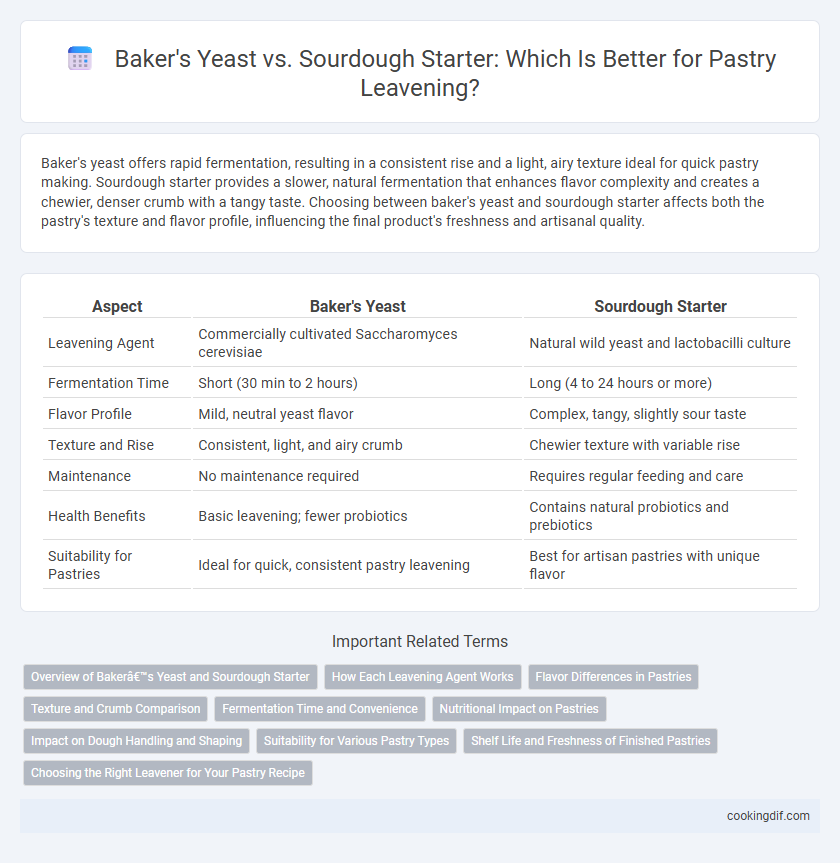Baker's yeast offers rapid fermentation, resulting in a consistent rise and a light, airy texture ideal for quick pastry making. Sourdough starter provides a slower, natural fermentation that enhances flavor complexity and creates a chewier, denser crumb with a tangy taste. Choosing between baker's yeast and sourdough starter affects both the pastry's texture and flavor profile, influencing the final product's freshness and artisanal quality.
Table of Comparison
| Aspect | Baker's Yeast | Sourdough Starter |
|---|---|---|
| Leavening Agent | Commercially cultivated Saccharomyces cerevisiae | Natural wild yeast and lactobacilli culture |
| Fermentation Time | Short (30 min to 2 hours) | Long (4 to 24 hours or more) |
| Flavor Profile | Mild, neutral yeast flavor | Complex, tangy, slightly sour taste |
| Texture and Rise | Consistent, light, and airy crumb | Chewier texture with variable rise |
| Maintenance | No maintenance required | Requires regular feeding and care |
| Health Benefits | Basic leavening; fewer probiotics | Contains natural probiotics and prebiotics |
| Suitability for Pastries | Ideal for quick, consistent pastry leavening | Best for artisan pastries with unique flavor |
Overview of Baker’s Yeast and Sourdough Starter
Baker's yeast, a commercially produced strain of Saccharomyces cerevisiae, offers rapid fermentation and consistent leavening, making it ideal for quick pastry preparation. Sourdough starter, a natural fermenting culture composed of wild yeast and lactic acid bacteria, imparts complex flavors and extended fermentation times that enhance pastry texture and aroma. Both play crucial roles in pastry making, with baker's yeast providing predictability and sourdough starter delivering artisanal depth.
How Each Leavening Agent Works
Baker's yeast leavens pastry through the fermentation of sugars, producing carbon dioxide and alcohol that create air pockets and cause the dough to rise quickly. Sourdough starter relies on a symbiotic culture of wild yeast and lactic acid bacteria, which ferments sugars more slowly, contributing to complex flavors and a natural leavening process. The slower fermentation time in sourdough allows gluten development and enhanced texture, while baker's yeast provides rapid, consistent leavening ideal for quick pastry preparation.
Flavor Differences in Pastries
Baker's yeast produces a mild, consistent rise with a subtle sweetness that enhances the delicate texture of pastries without overpowering other flavors. Sourdough starter imparts a complex, tangy acidity and depth, creating pastries with a richer, more robust flavor profile and a slightly chewy crumb. The choice between baker's yeast and sourdough starter significantly influences the aromatic and taste characteristics, with sourdough offering more nuanced and layered flavor notes.
Texture and Crumb Comparison
Baker's yeast produces a light, airy texture with uniform crumb structure in pastries, ideal for achieving a tender, soft bite. Sourdough starter contributes a denser, chewier crumb with complex flavor profiles and irregular holes, enhancing artisanal texture and extended freshness. The choice between the two impacts not only leavening speed but also the pastry's overall mouthfeel and durability.
Fermentation Time and Convenience
Baker's yeast provides rapid fermentation, allowing pastries to rise quickly within 1-2 hours, ideal for time-sensitive baking and ensuring consistent results. Sourdough starter requires extended fermentation, often 8-24 hours, enhancing flavor complexity and texture but demanding more planning and attention. Convenience favors baker's yeast for fast preparation, while sourdough benefits artisanal pastry applications where slow fermentation is valued.
Nutritional Impact on Pastries
Baker's yeast in pastries primarily contributes to faster fermentation, resulting in a lighter texture but with lower nutritional benefits compared to sourdough starter. Sourdough starter enhances the nutritional profile by promoting the growth of beneficial lactic acid bacteria and yeast, which improves mineral availability and increases the level of antioxidants. This natural fermentation also breaks down phytic acid, improving digestion and nutrient absorption in pastries.
Impact on Dough Handling and Shaping
Baker's yeast produces a rapid rise with consistent gas release, resulting in a dough that is easier to handle and shape due to its predictable elasticity and uniform texture. In contrast, sourdough starter ferments more slowly, creating a dough with a more complex gluten structure that can be stickier and less extensible, demanding greater skill during shaping. The acidity and longer fermentation time of sourdough dough enhance flavor but often require more careful manipulation to maintain shape and achieve desired crumb characteristics.
Suitability for Various Pastry Types
Baker's yeast provides consistent and rapid leavening, making it ideal for flaky pastries like croissants and puff pastries that require precise rise times and layered textures. Sourdough starter offers a slow fermentation process that enhances flavor complexity, making it better suited for rustic, artisanal pastries such as sourdough Danish or brioche with a tangy note. The choice between baker's yeast and sourdough starter depends on the desired texture, flavor profile, and fermentation timing specific to each pastry type.
Shelf Life and Freshness of Finished Pastries
Baker's yeast-fermented pastries typically have a shorter shelf life due to rapid fermentation, which can lead to quicker staling and loss of freshness within one to two days. Sourdough starter extends the freshness of finished pastries by producing organic acids that act as natural preservatives, often maintaining softness and flavor for up to a week. This natural acidity also slows mold growth, contributing to longer shelf stability compared to yeast-leavened products.
Choosing the Right Leavener for Your Pastry Recipe
Baker's yeast provides a consistent and rapid rise, ideal for lighter pastries such as brioche or croissants that require a delicate crumb and uniform texture. Sourdough starter, rich in natural wild yeasts and lactic acid bacteria, imparts complex flavors and a denser, chewier crust, making it perfect for artisan pastries and those seeking a tangy depth. Selecting the right leavener depends on the desired flavor profile, texture, and fermentation time of your pastry recipe.
Baker’s yeast vs Sourdough starter for pastry leavening Infographic

 cookingdif.com
cookingdif.com